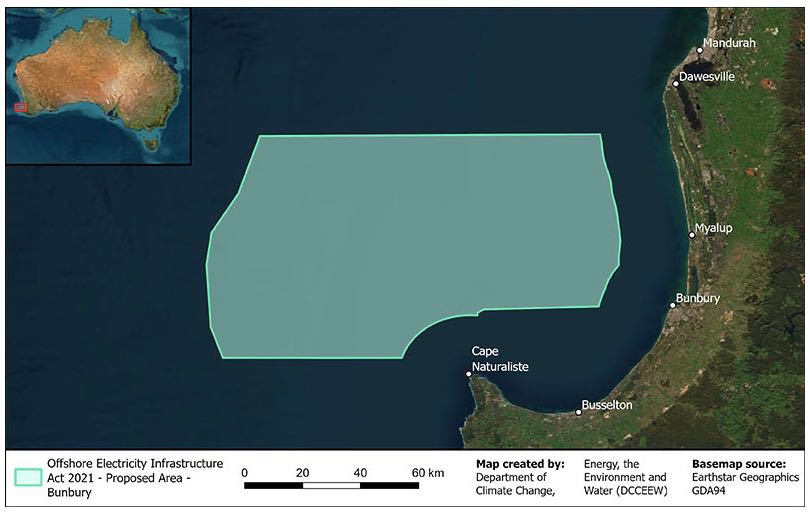Introduction
|
This puts it entirely in federally controlled waters. The question arrises: is this due to frustration in the federal government over the go-slow on renewables attitude of the WA government?
The information on the zone proposal can be read on the DCCEEW site.
What impact will the zone have on the region if the wind farms are built?
I have written on possible environmental impacts that the wind farms, if built in the zone, may have on another page on this site.If the zone is approved and developed it will:
- Provide hundreds or thousands of well paid jobs to the local people over the many years of construction and over the many more years of operation;
- Provide business to local accommodation providers, restaurants, hotels, etcetera;
- Provide work for local contractors;
- If the full 20GW of wind farms are built and the electricity displaces coal-fired generation about 190,000 tonnes of greenhouse gasses will be abated every day, if it displaces gas fired generation the figure will be about 96,000 tonnes per day;
- Not least it will give the local people a progressive feature that they can all be proud of.
Contrary to dishonest claims made by the less scrupulous opponents:
- It will not adversely impact the coastal lifestyle of the local people (it is, after all, 20km and more off the coast);
- It will not impact the use of beaches;
- It will not impact recreational fishing;
- It will not cause higher power bills, if anything it will cause lower power bills. Wind power is one of the cheapest forms of electrical generation. (Nuclear energy is by far the most expensive for of electricity generation. It makes no sense for Australia.)
Other concerns
A reef
I have heard a concern that the wind farms, if constructed, will adversely impact "the reef" without any further information being given.I was only able to find a little information about two reefs in the general area:
- Naturaliste Reef is an area of shallow water 25 nautical miles (46 kilometres) due west of Bunbury. One reference stated that there is "good fishing there, but nothing to see or do other than fishing". A nautical chart indicated that it occupies perhaps one percent of the proposed offshore Windfarm zone. It could easily be excluded from turbine development if it has any environmental or recreational significance. I was not able to find any further useful information about Naturaliste Reef.
- There is an artificial reef made of concrete blocks 6.5 kilometres north west of Bunbury Marina. (A page on a site called MadMackie was more informative than anything else that I found.) As the closest wind turbines will be 20km from the coast I can't see that there is likely to be any adverse impact on the artificial reef.
|
|
|
Mr Hastie's attack on the proposal
At the time of writing, March 2024, Andrew Hastie was the federal member of parliament (MHR) for Canning, which covers the northern part of the coastal area near the proposed wind farm zone.I have written at some length about Mr Hastie's misleading attack on the proposed offshore wind farm zone on my Wind Power Lies page where Mr Hastie was awarded the lie of the month entry for February 2024. I also wrote a page about Mr Hastie's dishonesty and on another page I suggested a search for an honest, progressive Community Independent candidate to take the seat of Canning from Mr Hastie.
Community Independents have taken seats in the Australian federal parliament from several other disreputable politicians at the last federal election. With any luck we'll see more unethical MPs, like Mr Hastie, loose their seats in the next federal election. The number of honest, community minded, climate change aware, independent politicians that were elected in the 2022 federal election seems to me the most optimistic event in Australian politics for many years. I will do what little I can to support the movement.
|
Nola Marino, MHR for Forest
At the time of writing, March 2024, Nola Marino was the federal member of parliament (MHR, Member of the House of Representatives) for Forest, which covers the southern part of the coastal area near the proposed wind farm zone. Ms Marino and Mr Hastie have neighbouring electorates, both are Liberals.Ms Marino has been far less blatantly opposed to the offshore wind farm zone and far more honest than her parliamentary neighbour to the north. But she does need to take more care in her research.
Ms Marino made a speech in Parliament in which she said, three times, words to the effect that "the life span of wind turbines ranges from 10 to 15 to around 20 years".
That didn't sound right to me so I did a little more research than Ms Marino has apparently done - it only took me a couple of hours. I found that Australia's six oldest wind farms of any substantial size, built back in the period from 2000 to 2003 are still running. I've given more detail on my page on Wind power problems, alleged problems and objections in a section titled 'Old Australian wind farms'. (On that page too is a chronology of wind power construction in Australia over the years to 2018.)
So at ages of 21 to 24 years, Australia's oldest wind farms are still running. Did Ms Marino understate the lifespan of wind turbines intentionally, or was is just carelessness?
